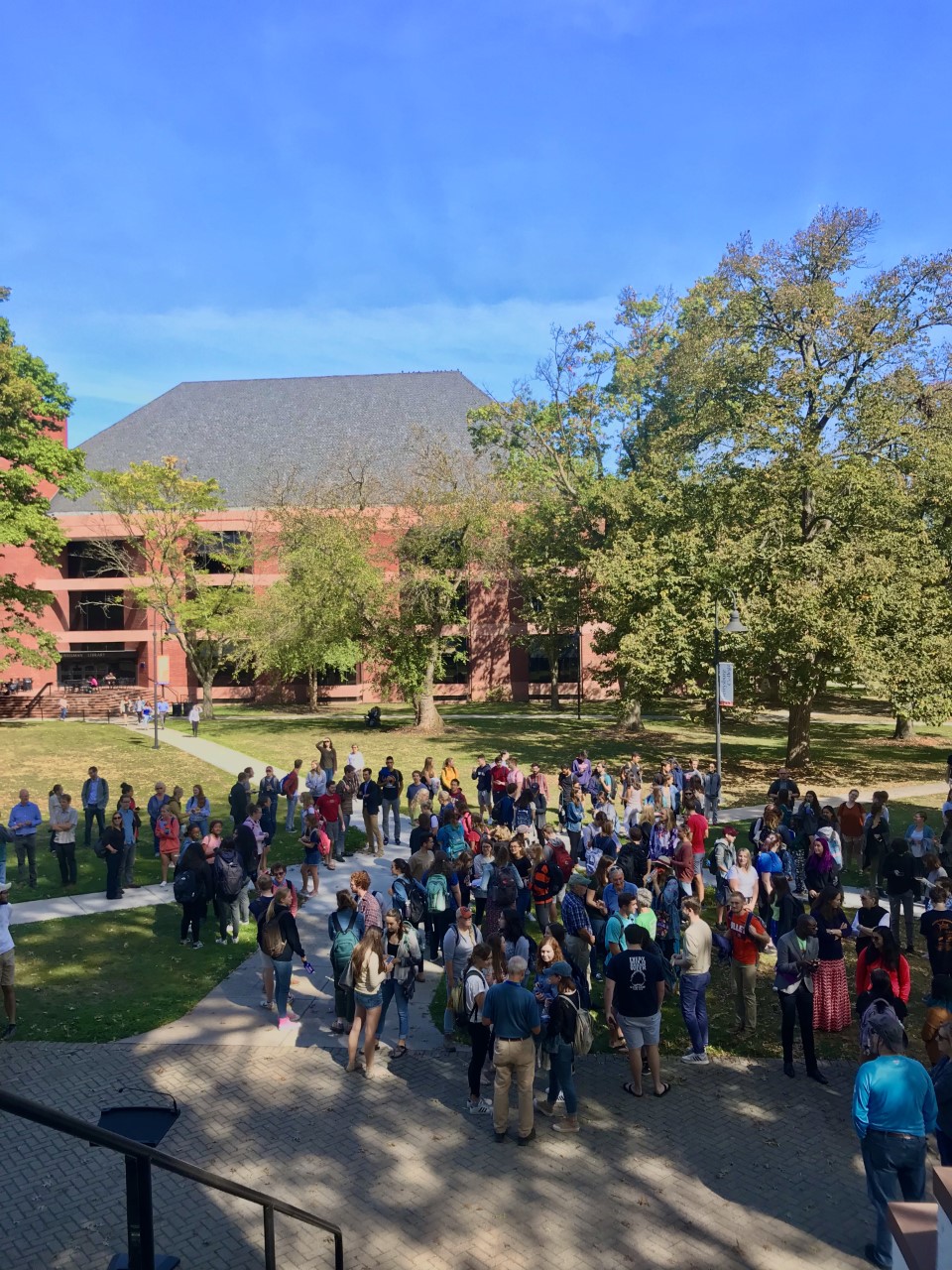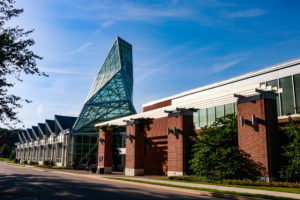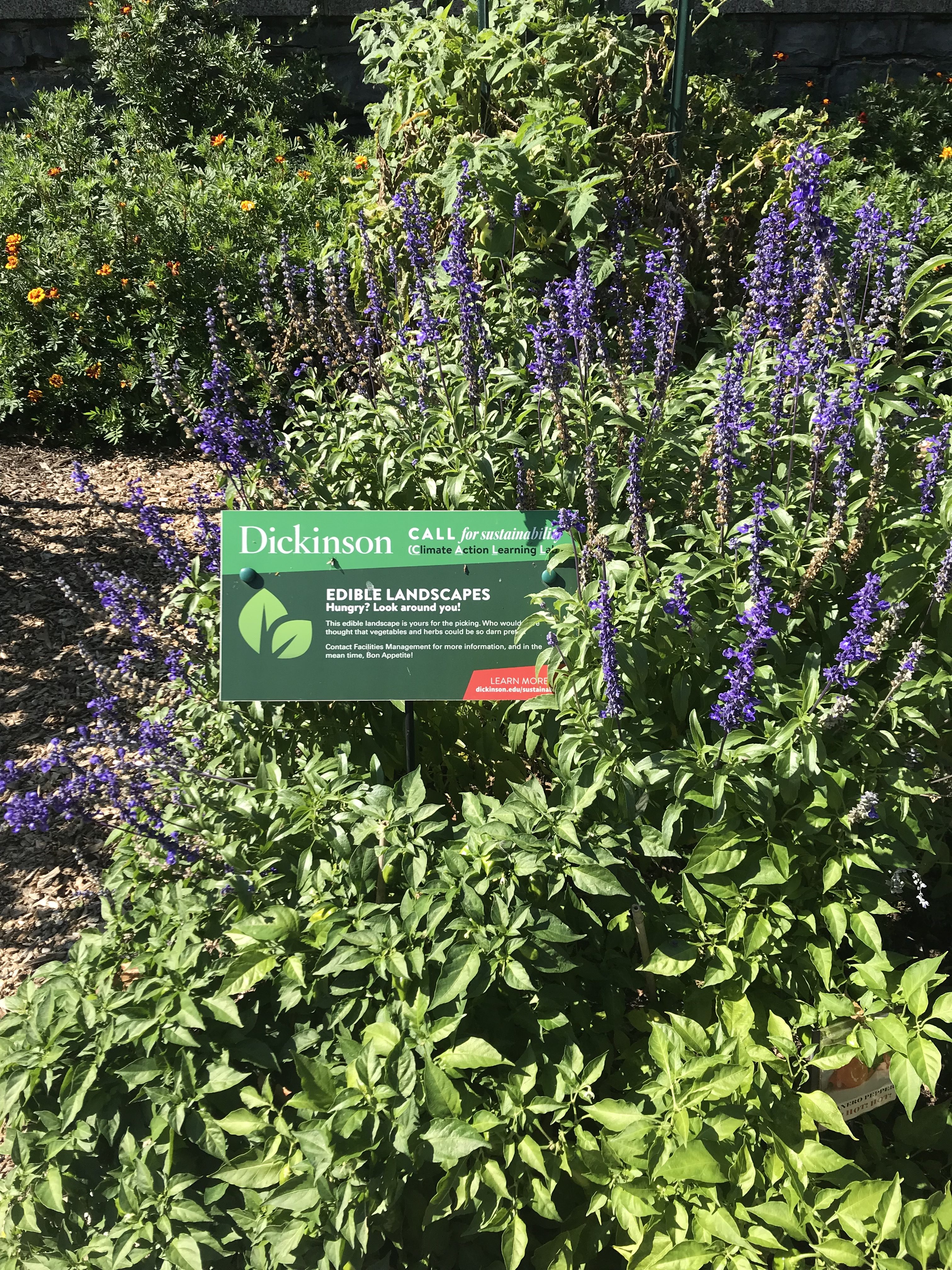College Shows Progress on Sustainability, Advocates Want More Campus Engagement
By Nicole DeJacimo, Assistant News Editor
Over the past ten years, Gettysburg College has reduced its net carbon emissions by nearly 50 percent through energy upgrades, energy-efficient new construction, and purchasing carbon offsets. News of that progress, though, has been slow to diffuse, and student activists bemoan the lack of a more coordinated public commitment to making the campus more sustainable.
History & Current Status of Sustainability at Gettysburg
Gettysburg College’s formal commitment towards carbon neutrality began in 2007 when then-President Katherine Haley Will signed the American College and University Presidents’ Climate Commitment, the (ACUPCC), in which the college agreed to:
- Complete an emissions inventory
- Set a target date and interim milestones for becoming climate neutral
- Take immediate steps to reduce greenhouse gas emissions by choosing from a list of short-term actions
- Integrate sustainability into the curriculum and make it part of the educational experience
- Make the action plan, inventory and progress reports publicly available
Two years after the administration signed the 2007 Strategic Directions and the ACUPCC, the college adopted the 2009 Climate Action Plan (CAP): a twenty-three-year strategy that would ultimately result in a carbon-neutral campus.
That plan set a goal to get the college to carbon neutrality by 2032, the year of Gettysburg’s 200th anniversary, and set an intermediate benchmark to show a 30 percent reduction in emissions by 2025.
According to the most recent data available from Second Nature, which tracks and reports on the college’s emissions, as of 2018, the college has achieved a 47.92% decrease in net emissions since 2006.
College spokesperson Jamie Yates points to that decrease as evidence of the college’s success in reducing its ecological footprint.
“Recognizing our collective responsibility as stewards of the environment, the College has a strong history of implementing innovative approaches to reducing our ecological footprint,” she said in an email. “Due to the College’s commitment and efforts in this area, we have already surpassed that goal and are showing a reduction of around 50 percent.”
She pointed to the installation of LED lights around campus, updates to the College Transportation System and practices, upgrades to dining equipment and processes to eliminate waste and water usage, and ensuring that large construction projects are Leadership in Energy and Environmental Design (LEED) certified as specific ways the college has pursued sustainability. Currently, the renovated part of the College Union Building is under review to determine whether or not it is LEED certified. Yates reported that the administration will hear back later this fall.
Public Commitment
Soon after sustainability was launched with much fanfare as a campus priority late in the Will administration, it all but disappeared from the campus consciousness when President Janet Morgan Riggs took office in 2008.
Other than the accomplishment of completing the construction of the Jaeger Center and “securing $10.3 million in gifts towards this project and achieving Gold LEED certification,” sustainability is not listed among the goals accomplished or still in progress in the 2011 updated strategic plan. The 2016 strategic plan similarly makes no mention of sustainability.
Yates defended the absence of sustainability from the strategic plan, arguing that sustainability efforts are “identified at the office and department level rather than in a high-level document such as the strategic plan: creating a more sustainable campus is a College-wide goal and the progress we’ve made is evidence of that.”
But to current and former employees of the college and members of the faculty with a role or interest in sustainability, the omission is a microcosm of the college’s systemic failure to engage the campus community in a shared commitment to making Gettysburg more sustainable.
“If there is a new strategic plan it would be great to see sustainability listed as a higher institutional priority,” Environmental Studies Professor Rutherford Platt said.
Recently, President Bob Iuliano met with the environmental studies department and told the department faculty of the college’s nearly 50 percent reduction in carbon emissions, which was news to them.
“After this morning’s meeting with the president,” Platt said, “we see that Iuliano is supportive of sustainability and climate change issues.”
Professor William Lane, who teaches in the English and environmental studies departments, helps organize Green Gettysburg, a task force within Gettysburg Area Democracy for America, which provides a forum in Gettysburg and the surrounding area to spread of information regarding environmental issues. In his view, those who want to live in a more sustainable world are part of the majority but do not always communicate with one another.
“One of our key tasks is to become more visible,” Lane said. He is hopeful that increased communication and conversation about sustainability will spark a new set of priorities for the institution and the community at large.
What Gettysburg College Is Doing
The Office of Facilities Planning & Management is ultimately responsible for implementing sustainability-related objectives at Gettysburg College, but that office has no full-time staff member in charge of such efforts despite the Climate Action Plan’s suggestion to hire a sustainability coordinator.
Instead, Facilities hires interns each summer who spearhead campus sustainability efforts and help to compile the college’s Greenhouse Gas report.
“The responsibility of sustainability really falls under Facilities, who hires the sustainability intern,” the 2019 sustainability intern Jack Burns ‘20 said. “Since there is no frontman, there’s no one to push new ideas. It’s a last thought for facilities because they have so much else to do.”
“Since there is no frontman, there’s no one to push new ideas. It’s a last thought for facilities because they have so much else to do.”
-Jack Burns, ‘20
Burns worked on campus over the summer to better understand what sustainability at Gettysburg College looked like. One of his primary projects involved expanding composting efforts in the college’s Dining Services. Burns identified an off-site facility that could take food waste from Servo and the Bullet Hole, but the college has not yet begun to use the service. One building on campus that composts is Farm House, a student-run College House, but this does not have a significant impact on the college when compared to the amount of food waste from the combined dining services.
Without an individual dedicated to coordinating institutional sustainability efforts, the locus of the college’s continuous efforts appears to be the purchase of carbon offsets.
Platt believes that carbon offsets can be part of the solution, but he does not think that they are the complete solution.
“Sometimes they are used to absolve the institutions of doing the harder work,” Platt said. “The other risk is that you don’t always know what you’re buying. So, I think it is important that carbon offsets are verified by a third party.”
“Sometimes [carbon offsets] are used to absolve the institutions of doing the harder work.” -Rutherford Platt
According to the college’s 2016 Greenhouse Gas report, the college has aggressively pursued the purchase of carbon offsets from Carbon Solutions Group.
“In 2008, Gettysburg College began purchasing carbon offsets, namely through purchasing energy from biomass or wind energy sources,” the report says. “We have counted these in the Third party verified carbon offsets purchased category.”
Yates did not address a question about the portion of the college’s carbon emissions reduction that can be attributed to the purchased offsets.
“The purchasing of offsets to achieve carbon neutrality is a common approach,” said Yates. “We presently offset all of our campus electricity consumption by purchasing green-certified electric credits, representing little over 1% of our annual budget for electricity.”
The sum of this budget was not reported, but, in 2010, the college reported spending $23,000 to offset about half of the college’s electricity consumption.
“On average, the College spends about 2% of its annual operating budget on electricity and natural gas,” Riggs said in an interview with The Gettysburgian in 2015. “At our current consumption levels, investing in our own power generation would not be cost-effective.”
Riggs did not respond to whether or not this was still her stance, but according to Yates, partnering with an outside firm has reduced what the college spends on traditional energy sources.
“In 2011, the College partnered with a solar company to install a 366-kilowatt solar panel system on the Jaeger Center and Bream Wright House flat roofs,” Yates said. “The power produced from these panels supports a small percentage of the actual electric consumption of the Athletic complex.”
One area in which the college does not appear to have made significant progress since pledging to integrate sustainability into the curriculum as part of its 2007 agreement is in developing a “program that introduces all students to campus goals and teaches them how to help work towards those goals,” as “a required part of the First-Year Experience program.”
No such program is part of Orientation or the Charting Your Course extended orientation program for first-year students. The college’s 2018 progress evaluation states that “professors are given the freedom to include sustainability in their curriculum and course work.”
Taylor Brorby, who taught in the English Department during the 2017-18 academic year and who has an MFA in Creative Writing and the Environment, said that Gettysburg College’s lack of coordinated commitment to sustainability is frustrating but that it is “on par” with other institutions at which he has taught and studied. These include a large research institution, Iowa State University, and a smaller liberal arts college, Hobart and William Smith.
“My guess is that these issues might get taken on at the administrative level,” Brorby said, “but the marketing is failing.”
“My guess is that these issues might get taken on at the administrative level, but the marketing is failing.” -Taylor Brorby
Brorby did not see much of an activist culture at Gettysburg that would be necessary to push college administration to make dramatic changes.
Riggs conceded that her administration could have done more.
“This is an area that requires the continued focus of the College community,” she said. “Of course there are many areas and initiatives on which I would have liked to have made more progress during my time as president—and I would suspect any college president would say the same.”
Current Student Efforts

Students, faculty, and staff joined at a rally to advocate for climate action on Sep. 20 (Photo Sam Hann/The Gettysburgian)
One instance of conspicuous campus activism came on Sep. 20 when about 200 Gettysburg students, faculty, and community members stood outside of Pennsylvania Hall as part of the Fridays for Future environmental protests, a global climate walkout.
“Hopefully it will draw attention [from] the faculty and staff that this is something we care about,” said Piper Mettenburg ‘21, one of the protesters.
“Hopefully it will draw attention [from] the faculty and staff that this is something we care about.” -Piper Mettenburg ‘21
Emma Fee ‘22 concurred.
“I hope that because we’re in front of Penn Hall we’ll show the administration where we stand on certain issues. Also, I think that it’s kind of a community message that this is where Gettysburg College stands along with the other campus communities,” she said.
President Robert Iuliano, Provost Christopher Zappe, and Dean of Students Julie Ramsey were among those who attended the protest and expressed support for the demonstration.
Zappe told The Gettysburgian that there still needs to be more education about climate change.
“I’m not going to prescribe any course of action,” he said. “From my own self-education on this topic I think there’s a lot for people to learn. So I view this again as educational.”
Iuliano, who took over as Gettysburg’s president in July, has yet to make a formal public statement on sustainability, but he has repeatedly encouraged students to voice their opinions about issues facing the world around them.
“I view that event as an example of the sort of activities that our students should engage in,” said Iuliano in a short interview following the climate strike. He said that no matter what kind of issues students champion, “the important point is [they’re] advocating for what [they] think is a better world.”
Current and former sustainability interns say that in the absence of coordination from the college administration, student activism cannot be particularly effective.
“Ultimately, there is an information gap between who creates the policies and how they are enforced,” Burns said. “If everyone is [being sustainable] as a mandate from the administration, that’s the only way we’re going to see real change.”
McKenzie Somers ‘20, who was a sustainability intern in the summer of 2018 and currently serves as President of the Gettysburg Environmental Concerns Organization (GECO), expressed little optimism about the potential for student activism to influence college administration to take more aggressive action.
“No matter how much GECO pushes for action or spreads awareness, it tends to fall on deaf ears,” Somers said. “The biggest setback was the fact that there isn’t a sustainability coordinator… No matter how much people care, if there isn’t a focus on the issue, nothing can get done.”
“No matter how much people care, if there isn’t a focus on the issue, nothing can get done.” -McKenzie Somers ‘20
Progress from Neighbors to the North
Other colleges have taken aggressive action to address climate and sustainability issues.
Dickinson President Margee Ensign said in an interview that her campus will achieve carbon neutrality by the end of this academic year.
Less than 30 miles north of Gettysburg, Dickinson College also adopted a Climate Action Plan in 2009. Dickinson President Margee Ensign said in an interview that her campus will achieve carbon neutrality by the end of this academic year, just eleven years after making a formal public commitment.
Dickinson has established a Center for Sustainability that organizes campus sustainability projects, which have included installing LED lights powered by a 3-megawatt solar field, encouraging students to turn toward plant-based diets, and establishing a bike-sharing program that reduces the need for cars on campus. Dickinson has also made aggressive use of offsets, though its plan emphasizes that they must be “secondary to mitigation projects that directly decrease emissions.”
Offsets were not to exceed 75 percent of campus emissions in 2020 when the college initially is to achieve neutrality and, by 2030, are to account for less than 25 percent of emissions.
Dickinson has also taken a public role in encouraging broader sustainability action by colleges and universities across the country.
“We are sharing our knowledge, experience, and expertise to help other colleges to advance sustainability on their campuses through participation in state-wide and national consortia,” Dickinson’s Vice President of Marketing and Communications Connie McNamara said.
She said that over 420 students and faculty of various colleges (including numerous students from Gettysburg) attended Dickinson’s BE.Hive conference in early October to discuss ways for college campuses to be more sustainable, which included changing individuals’ behaviors, using alternative forms of energy, and buying carbon offsets.
“Dickinson has trained 200-plus faculty members from over 60 colleges and universities to teach about sustainability and climate change at their institutions,” McNamara said.
Dickinson has invested more than $3 million in sustainability education efforts and claims that more than 140 courses “explore environmental, social, and/or economic dimensions of sustainability.”
The Path Forward
Gettysburg College appears to have made more progress in net emissions reduction than many seem to be aware. Coordinating a broader campus effort, then, is the college’s next frontier.
“We need to highlight our existing and future sustainability policies,” Platt said, adding that all future policies should be “evidence-based.”
Platt believes that the college has the ability to use student research as a way to determine which sustainability plans should be implemented; these studies would continue in order “to see the benefits or lack thereof.”
One public-facing initiative that has come to fruition happened earlier this fall when every Gettysburg student received a reusable bag that they can use at the Bullet Hole. Moving forward, non-reusable shopping bags cost 10 cents. Student Senate Sustainability Committee Chairperson Carolina Fernandes ‘22 reported that Bullet now sells fewer than 100 plastic bags per week, a decrease from around 700-800 single-use bags each week before charging for them.
The college has previously had a Sustainability Advisory Committee involved in campus sustainability efforts. After The Gettysburgian asked about its current membership and status, the college said it would move to reconstitute the group and its charge.
“Part of the charge will be for this group to educate campus on the everyday things each of us can do to reduce our own carbon footprint – for example, travel, laptops, and cellphones, are all central to the work we do but also add to the College’s overall energy consumption,” Yates said. “The more we can do to make these efforts a shared responsibility, the more progress we’ll be able to make.”
“The more we can do to make these efforts a shared responsibility, the more progress we’ll be able to make.” -Jamie Yates
More broadly, Yates signaled that sustainability will be a central priority at Gettysburg College in the years to come.
“The College will continue to view how it operates with a lens for sustainability as we anticipate ongoing enhancements,” she said, “however, we can always be doing more, as a society, and as a College.”
This article originally appeared on pages 4-10 of the October 31, 2019 edition of The Gettysburgian’s magazine.



